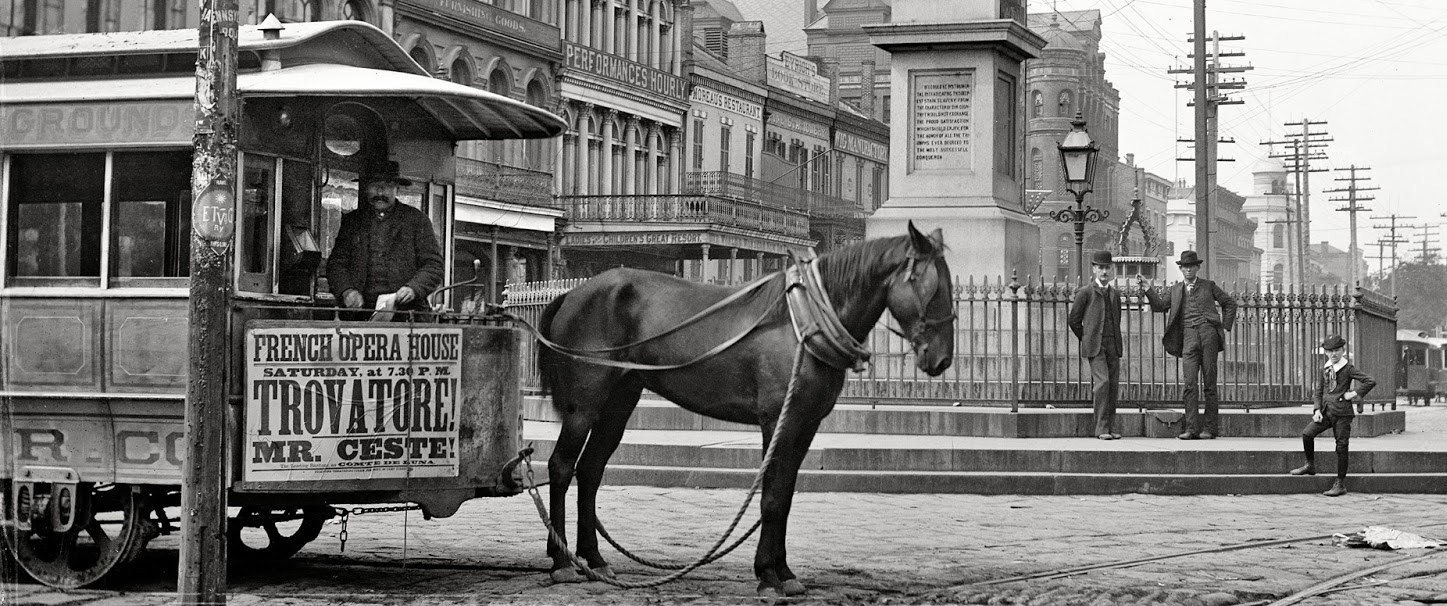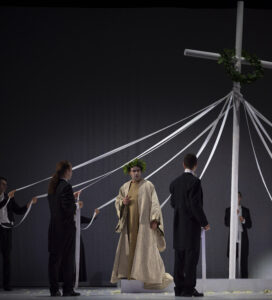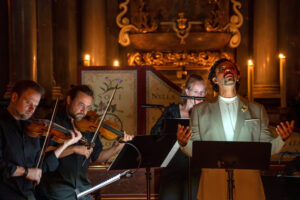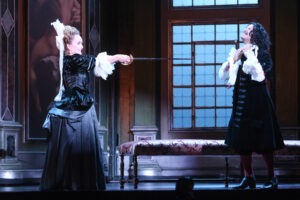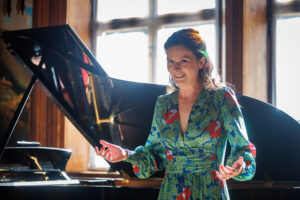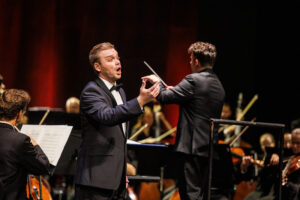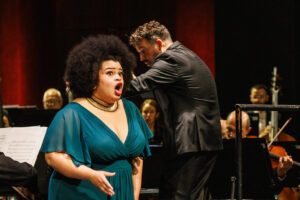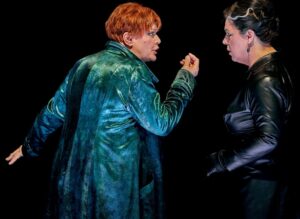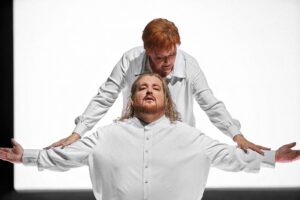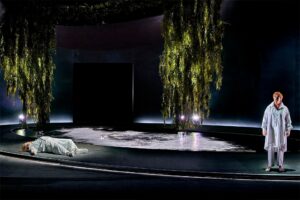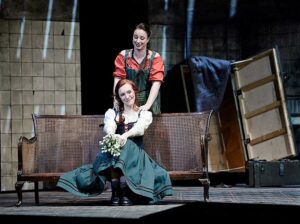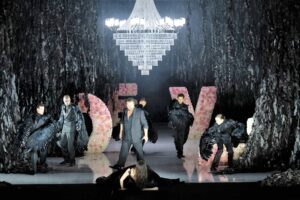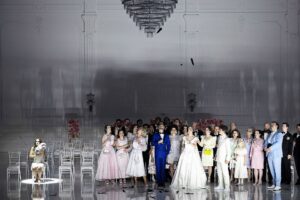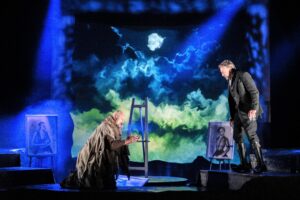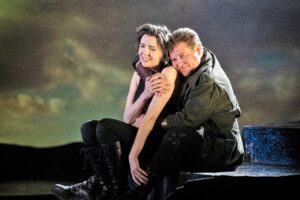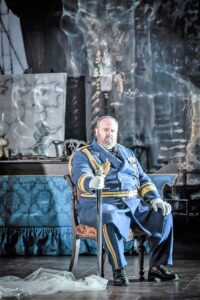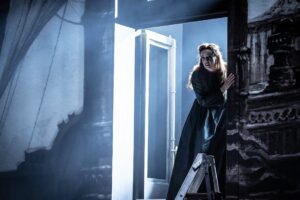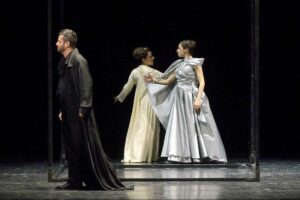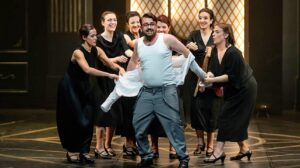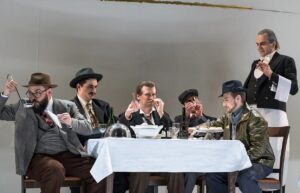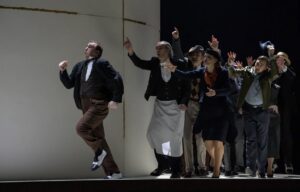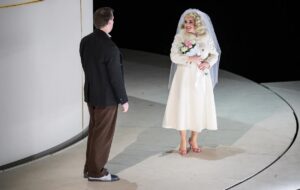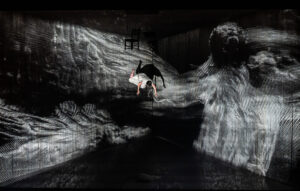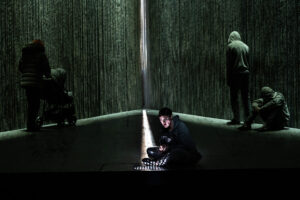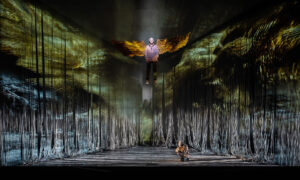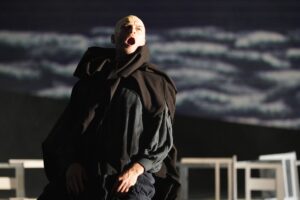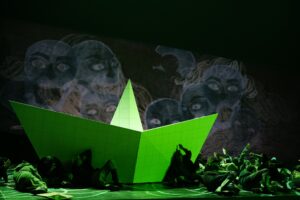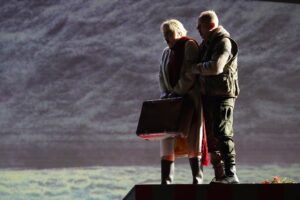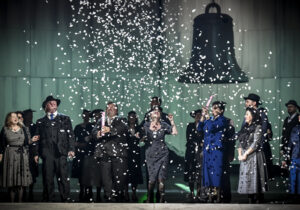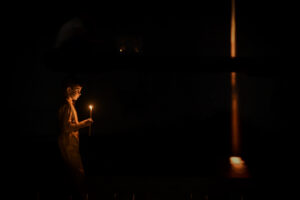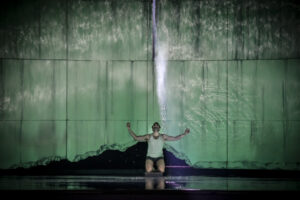Hell, Purgatory, Paradise
It is hard to believe that Bayreuth – the capital and second largest city of the Regierungsbezirk of Upper Franconia – is still almost exclusively associated with the Wagner Festival. Few people know that it was the birthplace of Christiane Eberhardine, the uncrowned queen of Poland – wife of Augustus II the Strong and mother of Augustus III – for whose funeral ceremony Bach composed the famous Trauer-Ode BWV 198. Tourists marvel at the gems of German Rococo in Dresden and Potsdam, having no idea of how many treasures of architecture of this style can be found in Bayreuth itself and on the outskirts of the city. Judaica devotees often fail to note that the Great Synagogue, which has been in operation since 1760, emerged almost unscathed from Kristallnacht: only because its building was adjacent to the Margravial Opera House. Few music lovers remember that this magnificent theatre, a UNESCO heritage site since 2012, hosted a baroque music festival already in the first decade of this century. The decision to revive the event, as Bayreuth Baroque, was not made until 2019, after a major renovation of the building.
Not only the Bayreuther Festspiele on the Green Hill, but also the new festival, under the artistic direction of Max Emanuel Cenčić, almost fell victim to the 2020 pandemic. Fortunately, the organisers managed to “squeeze” into the short break between the waves of the pandemic and hold Bayreuth Baroque under a strict sanitary regime, with no programme cuts. I went to Bayreuth at the time literally for just one evening, for a concert performance of Vinci’s Gismondo by the soloists and {oh!} Orkiestra led by Martyna Pastuszka.
In the years that followed Bayreuth Baroque managed to consolidate its reputation and attract new audiences to the city, which, much to the despair of its councillors, became deserted every time after the Wagner Festival ended. For various reasons I was unable to make it to the second and third instalments of the event, received increasingly well also by critics. This year I decided not to give up and to go to see performances of both staged operas included in the programme; sandwiched between them was a recital by a singer who has been all the rage recently among lovers of stylish performance of Baroque music.
Rolando Villazón as Orfeo. Photo: Clemens Manser
The performance of Monteverdi’s Orfeo, in a production directed by Thanos Papakonstantinou, left me confused, to say the least. The production is by no means new: this theatrical experiment, featuring live-electronics and material arranged and composed by Panos Iliopoulos, was premiered in 2017 at Athens’ Megaron. It was quite favourably received by Greek critics and ignored by most foreign reviewers – not without reason, as it was one of the many events accompanying the “true” celebrations of the 450th anniversary of the composer’s birth. The creative team honestly admitted at the time that it would be an Orfeo “with a twist”, a staging appealing to the sensibilities of audiences other than the supporters of historical performance truth. Indeed, there were plenty of surprises: from the addition to the Baroque instruments (Latinitas Nostra ensemble led from the harpsichord by Markellos Chryssicos) of, among others, the saw, bass guitar and theremin, the rather intrusive identification of Orpheus with the figure of Christ, to bizarre casting decisions. To make the matters worse, most of Iliopoulos’ ideas were not only in poor taste, but also contradicted the musical and dramatic logic of the original.
This is, in fact, also true of the staging, which, although quite pleasing to the eye (set design by Niki Psyhogoiu, lighting by Christina Thanasoula), puts spectators familiar with the work and the reception of Orphic literature in Monteverdi’s time to a severe test. Especially given that ideas like wedding dances with ribbons being wrapped around a cross (and a Latin cross at that) neither are revealing, nor reflect too well on the cultural competence of the creative team. Nor am I convinced by the concept of turning the entire opera into a thriller, announced already in the prologue, in which the famous toccata is replaced with a melody from an ominously jamming music box. Monteverdi resorts to a masterful dramatic trick, conducting the narrative of Act I in an atmosphere of growing joy and ecstasy – so convincing that the listeners forget what comes next; that the news of Eurydice’s death is as unexpected for them as it is for Orpheus. This adaptation oozes horror from the very beginning and everything is heading towards the final pandemonium, that is the version – abandoned by the composer – with a frenzy of maenads tearing apart the Thracian singer. I should add that this version was lost, so Iliopoulos went the whole hog and added something that had no connection to Monteverdi’s La favola d’Orfeo whatsoever.
Another thing is that he managed to spoil the original as well. His insertions and arrangements disrupted the chord base in the basso continuo to such an extent that the singers had trouble intoning their lines correctly. Chryssicos compounded this, further confusing the artists with his bizarre choice of tempi and disregard for the internal symbolism of key passages in the work (for example, in “Possente spirto”, a poignant clash of emotion and convention, which in this interpretation was more like the soundtrack to a B horror film). The soloists sang generally correctly but unstylishly, with an excessively wide vibrato, leaving out most of Monteverdi’s characteristic ornamental figures. The notable exception was Marios Sarantidis, who with his lovely, brilliantly controlled bass impressed already in the ensembles – unfortunately, as Charon he was effectively drowned out by the electronics. Different dilemmas were posed for me by Rolando Villazón’s participation in the venture. After his vocal crisis, his voice returned in a completely different form: smoky, gravelly, less wide in terms of range, which, however, the artist knows how to mask and even turn to his own advantage with his excellent technique and expressive interpretation. This time he did not succeed. In Act I his Orpheus was literally fighting to survive. After that things improved somewhat, although I could not shake the feeling that Villazón strayed into this experiment from a completely different story and got no support from anyone: neither the conductor, the director, nor the author of this bizarre adaptation.
After the performance all hell broke loose. Half of the audience booed like mad, drowned out by the other half with frenetic applause and shouts of enthusiasm. I hanged on in silence, feverishly gathering my thoughts and anxiously preparing for the following evening.
Bruno de Sá and the ensemble Nuovo Barocco. Photo: bayreuth.media
My fear proved unfounded. The recital by the Brazilian male soprano Bruno de Sá at the Baroque Ordenskirche St. Georgen, founded by Margrave George William for the courtly order of knighthood Ordre de la Sincerité, impressed not only with the quality of the performance and the deeply thought-out arrangement of the programme, but also with its unique atmosphere – it took place in an interior bathed in natural candlelight, in close contact with the musicians positioned in the middle of the Greek cross on the plan of which the church was built.
I needed such a purgatory after the hellish torments of the previous day. Let me start by praising the excellent Nuovo Barocco ensemble, founded by the Hungarian oboist Bettina Simon and the Greek violinist Dimitris Karakantas. Until recently, fans of historical performance could choose between the cold perfection of Northern European Baroque ensembles and the fiery, often sloppy element of the Southerners. Nuovo Barocco is part of a whole new trend of playing that is energetic and passionate, at the same time characterised by a dazzling, almost romantic beauty of sound, evident both in the accompaniments to the arias and in the instrumental pieces (phenomenally highlighted “sentimental” texture of Francesco Durante’s Concerto No. 2 in G minor ).
The musicians presented a programme made up of works by composers of the Neapolitan school: in the first part, Bruno de Sá sang arias intended for soprano castrati in female roles (Cunegunda from Gismondo and the eponymous heroine of Vinci’s Didone abbandonata, Sabina from Pergolesi’s Adriano in Siria and Ismena from Giuseppe Sellitto’s opera Siface); in the second – arias of male protagonists (Curiazio from Cimarosa’s Gli Orazi e I Curiazi, Volusio from Hasse’s opera Cajo Fabricio, Arminio from Porpora’s Germanico in Germania, and the aria “Son qual nave”, written by Riccardo Broschi for his brother Farinelli for the pasticcio opera Artaserse).
After the great revival of the countertenor voice, the time has come for the much more exclusive voice of male soprano, that is, the singing of men who, for various reasons, did not undergo mutation in adolescence. Of the three brightest stars in this rarefied vocal fach (I am also thinking of Samuel Mariño and Dennis Orellana), de Sá is unquestionably the most musical and technically the best. He is proficient in coloratura, can maintain a balance of tone in the transitions between registers, his phrasing is smooth and done with a great sense of style. In addition, his range is very wide – but it turned out not to be wide enough to meet all the challenges of the recital’s closing aria from Artaserse. The reason is simple: Farinelli moved with ease within a range of three and a half octaves and his breathing capabilities were remarkable even for a castrato.
And this raises the question of the usefulness of male sopranos in historical performance. Countertenors are unable to match the art of the castrati of the past either, but their voices are denser and more expressive. Bruno de Sá’s soprano, on the other hand, sounds like a lovely, incredibly well-trained voice of an adolescent girl, which necessarily limits the singer in his choice of female roles and almost disqualifies him as a performer of male roles in Baroque opera. It is unlikely that the problem will disappear in the future, when the pioneers –de Sá among them – will begin to give way to increasingly technically proficient male sopranos. This is because the problem is not in the technique, but in the physiology. In my opinion we should already start thinking about a suitable niche for male sopranos, whose instrument is fascinating, but much more delicate than that of most countertenors. I was reaffirmed in this belief by the encores of the singer, who was clearly tired at this point: from a not very convincing interpretation of “Tu del Ciel ministro eletto” from Handel’s Il trionfo del Tempo e del Disinganno, to “Ombra mai fu” from Bononcini’s Xerse, where even the dazzling timbre of his voice failed to mask the problem of tone stability.
Flavio, re de’ Longobardi. Julia Lezhneva (Emilia) and Max Emanuel Cenčić (Guido). Photo: Falk von Traubenberg
Yet overall the recital left a very good impression and I did not expect that the final performance of my trip, of Flavio, re de’ Longobardi, the fourth of Handel’s operas for the King’s Theatre, Haymarket, would take me straight to paradise. I can confidently say that I had not seen such a visually beautiful yet clever staging of a Baroque work for at least a decade. The creative team decided to stage the whole thing in the style of a courtly tragicomedy, highlighting the peculiar heterogeneity of this dramma per musica, which at times really verges on a parody of opera seria. Helmut Stürmer’s superbly designed sets, making up a new space again and again, provided a background for scenes reminiscent of Corneille’s and Molière’s theatre, Hogarth’s prints and Gainsborough’s paintings – possibly also filtered through Kubrick’s film adaptation of Barry Lyndon. However, the efforts of the set designer, costume designer (Corina Grămoşteanu) and lighting designer (Romain De Lagarde) would have been in vain, if it had not been for the direction of Max Cenčić, who, following the example of the greatest masters of opera theatre, derived this convoluted story not only from the libretto, but also from the score, phenomenally arranged the crowd scenes, and, at the same time, took care of every gesture, glance and change of facial expression of the singers as well as the several silent actors who were used in the action. Cenčić brilliantly weaves comedy and love with elements of the grotesque, sometimes on the verge of overdoing it, as in the episode when offspring is being conceived by Flavio, who fulfils his royal duty in front of a cheering court. However, Cenčić does not overdo it in the end – indeed, he forces laughter back down our throats when the debased queen emerges from her bed and, in the silence of the interrupted musical narrative, finds comfort in the tenderness of the court dwarf, who leads his mistress backstage, glaring at those present with contempt (excellent Mick Morris Mehnert).
There were many more such episodes in this performance, and the spectators had to swallow tears of emotion as often as they had to suppress violent fits of giggles. In several fragments the creative team invoked the convention of pasticcio, incorporating into the opera other works by Handel, instrumental compositions by Telemann, an aria from Lotti’s Theophane and Michel Lambert’s air de court “Vos mépris chaque jour” – that last piece performed by a lady-in-waiting singing delightfully out of tune (the actress Filippa Kaye). How on earth Cenčić managed to unleash such reserves of acting talent from all the cast members, I truly have no idea. All the more credit to him for that, as he assembled a dream cast. He himself took up the mantle of Senesino and sang the heroic role of Guido, in which he impressed not only with the luscious sound of his increasingly beautiful countertenor, but also with his extremely stylish ornamentation in da capo arias. The audience was completely bowled over by Julia Lezhneva in the role of Emilia, engaged to Guido: her round soprano was enriched with deeper, truly “feminine” tones and her improvisational skills were at their peak – I don’t know what purists would say, but in the third segment of the aria “Mà chi punir desio” she created a showpiece ornament from an excerpt from Nino Rota’s soundtrack to the film Romeo and Juliet. In the second pair of lovers Yuriy Mynenko (Vitige) was particularly worthy of note with his superbly placed soprano countertenor beautifully open at the top. He found a fine partner in Monika Jägerová (Teodata), a singer endowed with a contralto of extraordinary beauty, which in the last act, however, began to betray signs of fatigue. The eponymous Flavio was sung by the young French countertenor Rémy Brè-Feuillet, making up for minor technical shortcomings with an uncommon sense of comedy. The character roles of Ugone and Lotario were brilliantly performed by Fabio Trümpy and Sreten Manojlović – the former a bit better vocally, the latter incomparably better as an actor. The excellent as usual Concerto Köln orchestra was led from the harpsichord by Benjamin Bayl: precisely, with a flawless sense of the form of the work and the capabilities of the soloists involved in its performance.
When the applause finally died down, I really felt like an exile from the garden of delights. From now on, I will tirelessly seek to return. I have a vague feeling that this paradise can be regained. Because where I lost it, I now know for certain.
Translated by: Anna Kijak
